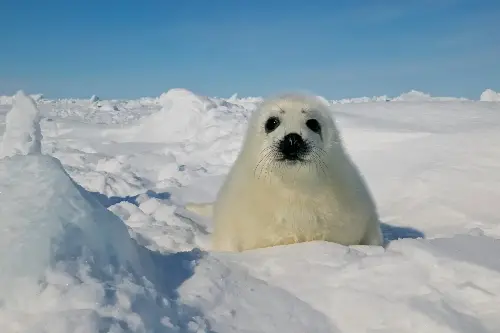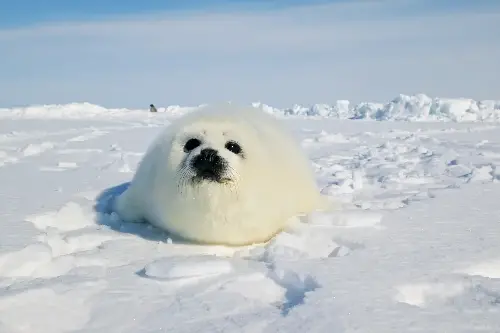Whiskered and winsome with a penchant for icy waters, harp seals are the endearing aquatic acrobats of the Arctic Ocean. These sleek swimmers, with their distinctive harp or wishbone-shaped black markings on their backs, capture the imagination with their grace and resilience in one of the planet's most extreme environments.
The harp seal, known scientifically as Pagophilus groenlandicus, is not just a testament to nature's spectacle; it is also a critical component of marine ecosystems. Native to the northernmost waters, these seals are primarily found in the North Atlantic and the Arctic Oceans, where they navigate a world of ice with remarkable agility.

Their life on the ice begins in dramatic fashion. Harp seal pups are born on the vast pack ice, their fluffy white coats providing camouflage against the predatory gaze of polar bears and other Arctic dangers. This white fur, however, is not a permanent feature. After about 12 to 15 days, pups begin to moult, revealing a silvery-grey fur beneath. It's not just their appearance that changes; this moulting period also sees the pups rapidly gain independence as they prepare to take to the sea.
Feeding primarily on fish such as capelin, Arctic cod, and herring, as well as crustaceans, harp seals have an intriguing way of hunting their prey. They utilise sensitive whiskers to detect the vibrations of their food sources in the dark waters beneath the ice. This advanced sensory equipment proves vital in the depths of the Arctic winter when sunlight is scarce and visibility is low.
Remarkably social creatures, these seals are not ones to traverse the icy landscapes solo. Outside of their mating season, harp seals can be observed basking on the ice in large groups known as 'patches'. During breeding season, these gatherings swell considerably, creating a cacophony of sounds that fill the crisp Arctic air.
The mating ritual of the harp seal is as curious as it is vital for their survival. After females give birth, they enter a brief but intense mating period that lasts only a few days. During this time, males perform elaborate displays and vocalisations to attract potential mates. Copulation takes place in the water, and following this, males have little to no involvement in raising the young. After the breeding season, harp seals roam widely, with some travelling up to 2,500 miles from their breeding sites, showcasing incredible endurance and navigational skills.

Adapted to a life in frigid waters, these mammals have a multi-layered approach to staying warm. Thick blubber underneath the skin insulates them from the cold, while their fur provides a waterproof barrier. Not to be forgotten is their ability to regulate blood flow to conserve heat, a trait common to marine mammals known as countercurrent heat exchange.
Harp seals are also famed for their incredible diving capabilities. They can dive to depths of over 300 metres and stay submerged for up to 15 minutes as they pursue prey or seek sanctuary from surface predators. These dives are not just physical feats; they represent the seal's intricate relationship with their icy habitat. It is this habitat, however, that faces a precarious future with the threat of climate change.
As our planet warms, the sea ice that serves as the nursery ground for harp seals is melting. With less ice on which to give birth and nurse their young, the species faces an uphill struggle for survival. Climate change also impacts prey availability. Changes in sea temperature can cause shifts in fish populations that the seals depend on, adding another layer of challenge to their existence.
Despite these threats, harp seals continue to swim through the Earth's pages as majestic symbols of the Arctic's biodiversity. Their conservation is a touchstone for international efforts to address climate impacts in the polar regions. Protecting the environments where they feed, mate, and rear their young means understanding more about these remarkable creatures and the intricate web of life to which they belong.

In the face of a changing world, these Arctic denizens teach us about adaptability, the wonders of nature, and the need for conscious preservation efforts. As they glide beneath the Northern Lights or bask on the dwindling ice, harp seals are a reminder of the delicate balance we share with all living creatures and the vast responsibilities we hold in protecting their place on this blue planet.
The next time we cast our thoughts northward, let it be with a sense of wonder and duty towards the harp seals and their frigid realm. These swift and sleek swimmers are not just Arctic inhabitants; they are barometers of ocean health and sentinels of an environment under threat. Through understanding and admiration, we can ensure these majestic creatures continue to play their vital role in the Arctic's marine symphony for generations to come.
